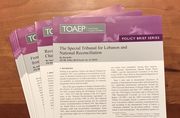Table of contents:
Element:
"The seizure of, destruction or wilful damage done to institutions dedicated to religion, charity and education, the arts and sciences, historic monuments and works of art and science constitute a violation of the law or customs of war under Article 3(d) of the Statute."[1]
"iv) the perpetrator acted with the intent to destroy the property."[2]
"does not concur with the view that the mere fact that an institution is in the 'immediate vicinity of military objective' justifies its destruction."[3]
"Nevertheless, the established jurisprudence of the Tribunal confirming the 'military purposes' exception which is consistent with the exceptions recognised by the Hague Regulations of 1907 and the Additional Protocols, persuades the Chamber that the protection accorded to cultural property is lost where such property is used for military purposes. Further, with regard to the differences between the Bla{ki} and Naletilić Trial Judgments noted above (regarding the use of the immediate surroundings of cultural property for military purposes), and leaving aside any implication of the issue of imperative military necessity, the preferable view appears to be that it is the use of cultural property and not its location that determines whether and when the cultural property would lose its protection. Therefore, contrary to the Defence submission, the Chamber considers that the special protection awarded to cultural property itself may not be lost simply because of military activities or military installations in the immediate vicinity of the cultural property. In such a case, however, the practical result may be that it cannot be established that the acts which caused destruction of or damage to cultural property were 'directed against' that cultural property, rather than the military installation or use in its immediate vicinity."[4]
"Turning now to the question of whether Religious Buildings had not been used for military purposes, the Appeals Chamber recalls that the Prosecution must establish that the destruction in question was not justified by military necessity; this cannot be presumed. Determining whether the Prosecution has fulfilled its burden of proof in a particular case necessarily requires that the trier of fact, considering all direct and circumstantial evidence, assess the factual context within which the destruction occurred. Determining whether destruction occurred pursuant to military necessity involves a determination of what constitutes a military objective. Article 52 of Additional Protocol I contains a widely acknowledged definition of military objectives as being limited to 'those objects which by their nature, location, purpose or use make an effective contribution to military action and whose total or partial destruction, capture or neutralisation, in the circumstances ruling at the time, offers a definite military advantage'. [...]Witness Radić (a leading politician within the ARK), testified that the purpose of th destruction of mosques was to prevent people from returning. [...]The evidence referred to in the Trial Judgment in relation to the religious sites destroyed in the territory of the ARK in 1992 does not suggest that any of these sites may have been used for military purpose, or that their total or partial destruction offered a definite military advantage to the Bosnian Serb forces. Brđ;anin refers to no such evidence on appeal. To the contrary, there is evidence that these sites were destroyed as a part of a campaign to ethnically cleanse the area of its Muslim and Croat citizens. This is consistent with the Trial Chamber's findings regarding 'the deliberate campaign of devastation of the Bosnian Muslim and Bosnian Croat religious and cultural institutions', which 'was just another element of the larger attack. The final objective, however, was the removal of the population and the destruction of their homes'.[...]The very manner in which many of the sites were damaged or destroyed, including the time required to mine churches, mosques, and minarets and to blow them up (or to set them on fire), suggests that these installations contained no military threat, but were instead systematically destroyed because of their religious significance to the ethnicities targeted. There is nothing to suggest that their destruction provided any kind of advantage in weakening the military forces opposing the Bosnian Serbs, favoured the Bosnian Serb position, or was otherwise justified by military necessity. In light of the foregoing, Brđ;anin has failed to demonstrate that the Trial Chamber's findings were findings which no reasonable trier of fact could have made beyond reasonable doubt."[5]
Prosecutor v. Jadranko Prlić, Case No. IT-04-74-T, Judgement (TC), 29 May 2013, para. 177:
"177. The Praljak Defence argues that the second paragraph of Article 27 of the above-mentioned Hague Regulations requires that the protected building have “distinctive” and “visible” signs. The Chamber joins the Praljak Defence in saying that both the Hague Regulations and Articles 6, 16 and 17 of the 1954 Hague Convention contemplate the use of distinctive signs on historic and cultural monuments in wartime. However, the Chamber would add that not using such a sign does not in any event withdraw protection from the property provided that the property has not been transformed into a military objective."
"Likewise (in respect of the offence of destruction of institutions dedicated to religion or education alleged in Counts 43 and 44), the HVO deliberately targeted mosques and other religious and educational institutions. This included the Ahmići mosque which the Trial Chamber finds was not used for military purposes but was deliberately destroyed by the HVO. Accordingly, the Trial Chamber finds that the underlying offences in Counts 43 and 44 are made out (save in relation to the locations deleted at the close of the prosecution case)."[6]
"The Trial Chamber notes that educational institutions are undoubtedly immovable property of great importance to the cultural heritage of peoples in that they are without exception centres of learning, arts, and sciences, with their valuable collections of books and works of arts and science. The Trial Chamber also notes one international treaty which requires respect and protection to be accorded to educational institutions in time of peace as well as in war."[7]
"The damage or destruction must have been committed intentionally to institutions which may clearly be identified as dedicated to religion or education and which were not being used for military purposes at the time of the acts. In addition, the institutions must not have been in the immediate vicinity of military objectives."[8]
4.1.2. Evidence that the object of the attack is a historic monument
"the Chamber observes that the Old Town of Dubrovnik in its entirety was entered onto the World Heritage List in 1979 upon the nomination of the SFRY. The properties inscribed on the World Heritage List include those which, 'because of their architecture, their homogeneity or their place in the landscape, are of outstanding universal value from the point of view of history, art or science.' The Chamber is of the view that all the property within the Old Town, i.e. each structure or building, is within the scope of Article 3(d) of the Statute."[9]
4.2. The objects were not military objectives
"The Chamber therefore concluded, regarding elements of evidence, that the destruction of the Skrobućani mosque in May or June 1993 by members of the HVO constituted a deliberated destruction of a building dedicated to religion, crime mentioned in the Article 3 of the [ICTY] Statute."[10]
Footnotes:
[1] ICTY, Prosecutor v. Naletilić and Martinović ("Tuta and Štela"), "Judgment", IT-98-34-T, 31 March 2003, para. 603.
[2] ICTY, Prosecutor v. Naletilić and Martinović ("Tuta and Štela"), "Judgment", IT-98-34-T, 31 March 2003, para. 605.
[3] ICTY, Prosecutor v. Naletilić and Martinović ("Tuta and Štela"), "Judgment", IT-98-34-T, 31 March 2003, para. 604.
[4] ICTY, Strugar Trial Judgment, 31 January 2005, para. 310.
[5] ICTY, Brđanin Appeal Judgment, 3 April 2007, paras.337-342.
[6] ICTY, Kordić and Čerkez Trial Judgment, 26 February 2001, para. 809; ICTY, Blaskić Trial Judgment, 3 March 2000, disposition; ICTY, Karadžić and Mladić, Rule 61 Decision, paras. 15-16; ICTY, Naletilić and Martinović ("Tuta and Štela") Trial Judgment, 31 March 2003, paras. 603-610.
[7] ICTY, Kordić and Čerkez Trial Judgment, 26 February 2001, para. 360.
[8] ICTY, Blaskić Trial Judgment, 3 March 2000, para. 185: Also, see ICTY, Kordić and Čerkez Trial Judgment, 26 February 2001, para. 361.
[9] ICTY, Strugar Trial Judgment, 31 January 2005, para. 327 (footnotes omitted).
[10] ICTY, Prosecutor v. Prlić, "Judgment", IT-04-74-T (vol. 3), 29 May 2013, paras. 1600-1601 (footnotes omitted) [unofficial translation from French].







